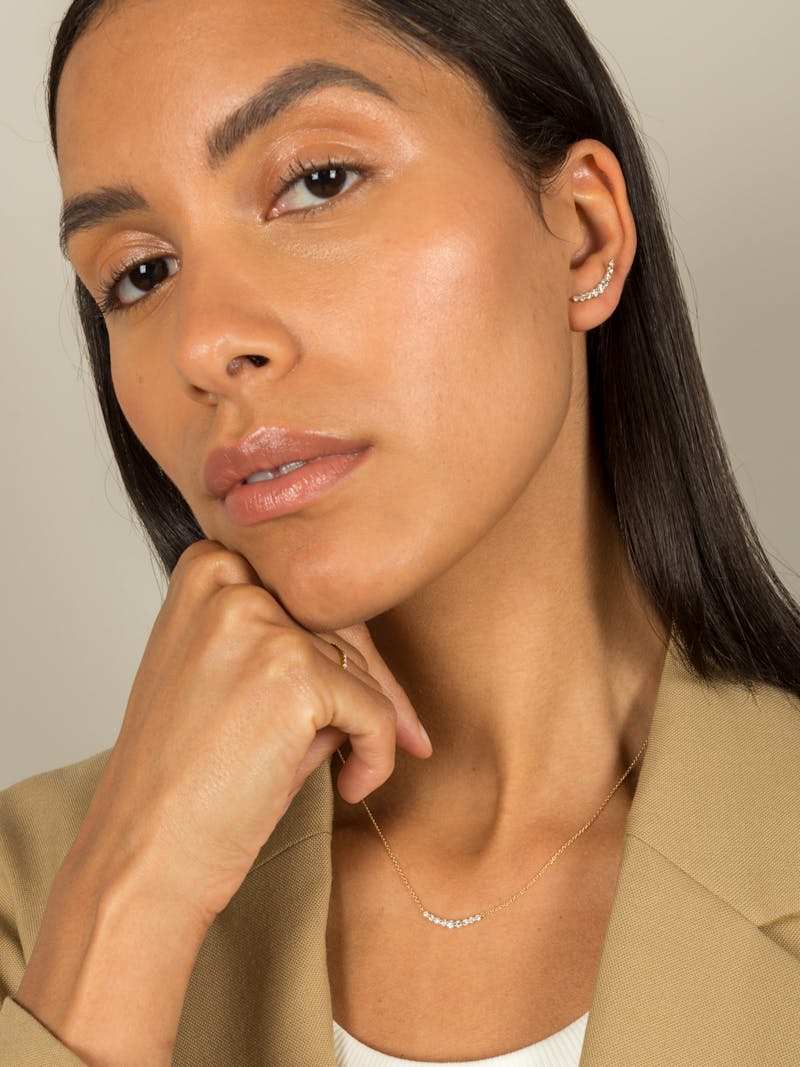What’s the difference between demi-fine, fine and high jewellery?

What exactly is ‘fine’ jewellery and how does it differ from ‘high’ or ‘demi-fine’ jewellery? There are myriad names in which to define and categorise jewellery and it can all be slightly confusing, even intimidating! Fear not, for we are here to demystify it all for you, and the good news is, you will see it’s much less complicated than you may have initially thought.
A somewhat superficial but effective shortcut to identifying whether something is ‘high’ or ‘fine’ or ‘demi fine’ jewellery is simply by looking at the price tag. If it’s a conspicuously high price tag, the likelihood is that the piece could be high or fine jewellery.
How to pick the right fine jewellery piece?
Picking the right piece of fine jewellery can be a challenge as there really is so much brilliance on offer. If this is your first time buying a fine piece, we would suggest choosing something that has emotional resonance. This could mean being drawn to a certain design, designer or texture. Another good entry point is choosing something that is personalised such as a design that includes your or your significant other’s birthstone, initials or a mantra that is engraved.
Can you renew fine jewellery?
What’s more, is that should you decide to remodel your piece of jewellery down the line, you can disassemble the mounted stones, melt down the metal (gold or otherwise) and refashion the jewellery into a different piece of jewellery. It’s by and away more sustainable than buying and rebuying assembly-line made jewellery which has no lasting runway as it tarnishes and oxidizes very quickly.
Is fine jewellery prone to tarnishing?
Fine jewellery isn’t totally inoculated from tarnishing either, even with all its Herculian features. The reason for this is that most of the metals upon which the stones are set are not 100% pure gold / silver, as pure metals are simply too soft to hold the diamonds and gemstones. Therefore it’s more common to see jewellery made up of 9, 14 and 18 karat gold which all include a portion of other metal alloys such as brass and nickel which make the metal stronger but can also slightly wear over time. Ditto sterling silver which is 92.5% pure silver mixed with 7.5% of copper. The impure nature of the metals mean they can slightly tarnish over time. You can read how to protect your jewellery in our aftercare guide which gives advice on how to best care for your jewellery so it can stay as new and intact as it did when you first laid eyes on it. All it really needs is a little sensible care.
What is demi-fine jewellery?
If we take it down a notch again, we are now entering the most accessible sphere of the three, aptly named demi-fine jewellery. ‘Demi’, which means ‘half’ in French, literally means what it is called. It is half fine jewellery! Demi’s mission is to make something look expensive but without the bulging price tag! The secret behind this is that the materials incorporated for this particular family of jewellery is at a cheaper price point. The technique of ‘vermeil’ or ‘plating’ is commonly summoned to make a pendant, ring, earrings etc whilst retaining the real shiny gold component - but for at least a third of the price. How is this done you may wonder? Easy. The base metal is a less ‘precious’ metal, say for example sterling silver, which is then coated in 14, 18 even 24 karat gold. But the weight of real gold that is used, is significantly less than the whole piece of jewellery being a ‘solid’ piece of gold. So essentially vermeil or plating (these words are interchangeable) is a less precious metal alloy with an expensive real gold paint job, but because the amount of real gold is only used for exterior purposes, the price nosedives. All in all, if you are looking to bridge the gap between fine jewellery and costume jewellery without breaking the bank, then demi fine jewellery is your best friend.
What is high jewellery?
Let’s look at the most expensive of the lot; high jewellery. Think of this as the Rolls Royce category. This jewellery is generally handmade, bespoke and extremely rare, made up only of the finest materials. Here you will find ornate shapes with the biggest and highest quality diamonds, deeply hued gemstones, 24 karat gold or pure platinum. The result is unmistakably rarified and obviously expensive jewellery which is often made by top jewellers or conglomerate-backed jewellery houses. This level of jewellery also appeals to people for its investment purposes and will surely appreciate in price over time. But the truth is, you won’t stumble upon this jewellery haphazardly on the highstreet any time soon. Viewings are usually done by appointment only, in a surveillanced salon. For somewhat cheaper access, you can take a stroll down Old Bond street (if you’re in London) and marvel at the blindingly electric diamond knuckle dusters in the window!
Which jewellery is the better investment?
Ultimately fine jewellery is definitely our favourite family to buy within, and surprisingly the spectrum of expenditure can vary a lot, so it doesn't have to be overly expensive. You can choose a smaller, daintier piece and because of its make and materials, you will be amazed to see how long you will have it for! Well made fine jewellery has the durability and strength to outlive you and I, perfect for handing down generation after generation. We also love its handmade nature whilst being as precious, stunning and elegant as it was always destined to be.
Our selection of independent jewellery makers handcraft each piece with only the finest materials and craftsmanship. As you're searching for what jewellery to wear, remember that each piece of jewellery is made to last a lifetime, ensuring lasting memories beyond.
 Earn Credit
Earn Credit.jpg?ixlib=gatsbyFP&auto=compress%2Cformat&fit=max&w=800&h=1067)
.jpg?ixlib=gatsbyFP&auto=compress%2Cformat&fit=max&w=800&h=1067)